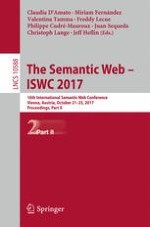2017 | Buch
The Semantic Web – ISWC 2017
16th International Semantic Web Conference, Vienna, Austria, October 21-25, 2017, Proceedings, Part II
herausgegeben von: Claudia d'Amato, Miriam Fernandez, Valentina Tamma, Freddy Lecue, Philippe Cudré-Mauroux, Juan Sequeda, Christoph Lange, Jeff Heflin
Verlag: Springer International Publishing
Buchreihe : Lecture Notes in Computer Science
